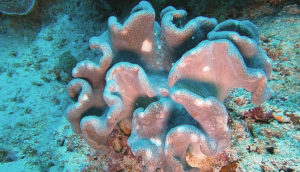The search for new natural products from the ocean is overlooking unique and potentially beneficial compounds, a Griffith University study has found.

Professor Tony Carroll, Coastal and Marine Research Centre and the Griffith Institute for Drug Discovery.
Published in Natural Products Reports, the research reports three quarters of the molecules being discovered from marine microbes are very similar to those found in backyard soil or plants.
“The marine environment remains a promising source for new bioactive molecules, but the methodological approach currently being taken is flawed,” said lead researcher Professor Tony Carroll from the Coastal and Marine Research Centre and the Griffith Institute for Drug Discovery.
“It selectively filters out novel microbes and funnels us towards those that we know how to grow and compounds we are already fairly familiar with,” he said.
“Based on a long-held premise that marine microorganisms are the true producers of the unique chemistry found in corals, sponges, and molluscs, in recent years there has been a shift away from studying these larger marine organisms in favour of the microbes.
“We think this folly is leading to missed opportunities for important drug discoveries for a diverse range of health conditions.”
The current approach to isolating new molecules from marine microbes relies on an initial step of growing the micro-organisms found in marine organism, sea water or sediment on nutrient rich growth media.
“The problem with the widely used method of isolating microbes for the discovery of new compounds is that these growth media have been specifically developed to grow well studied soil microbes, so they inadvertently screen out novel organisms that grow under different conditions,” said Tanja Voser, PhD candidate at the Coastal and Marine Research Centre.
“It is this procedural sieve that is leading to 76% of compounds identified from marine microbes overlapping with those reported from terrestrial microbes.
“For this reason, a decline in studies focusing on the chemistry of marine macro-organisms, has led to an overall drop in the discovery of unique chemistry from marine ecosystems.”

A species of sarcophyton or mushroom coral. Credit: Tony Carroll
Collecting samples from marine environments is estimated to be at least 10 times more expensive than similar terrestrial sampling.
“Researchers are spending a lot of time and energy collecting marine samples from isolated environments like deep sea trenches, only to filter out the interesting and unique microbes back in the lab,” Ms Voser said.
Tanja Voser, PhD candidate at the Coastal and Marine Research Centre.
“It’s a waste of resources that’s letting potentially beneficial molecules slip through the net.”
Where researchers haven’t subjected samples to this biological filter, they’ve discovered that the marine environment really is a bountiful source of unique chemistry.
“Marine cyanobacteria are a great example of microbes where we still find new chemistry,” Ms Voser said.
“Because the micobes clumps together in long hair-like strings we can collect large amounts of cyanobacteria without having to subject it to the growing process back in the lab. For this reason, a lot of unique molecules have been extracted from this marine micro-organism.
“We believe this paper will clearly highlights the key problems with the current focus on marine microbe natural products discovery and will hopefully create significant debate, innovation and widespread uptake of alternate methods in the field to overcome this issue.”


